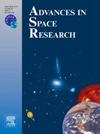Graph-GIC: A smart and parallelized geomagnetically induced current modelling algorithm based on graph theory for space weather applications
IF 2.8
3区 地球科学
Q2 ASTRONOMY & ASTROPHYSICS
引用次数: 0
Abstract
Geomagnetically Induced Current (GIC) refers to the electromagnetic response of the Earth and its conductive modern infrastructures to space weather and would pose a significant threat to high-voltage power grids designed for the alternative current operation. To assess the impact of space weather on the power grid, one needs to calculate the GIC on a national or continental scale. In this study, we developed a smart and parallelized GIC modelling algorithm, Graph GIC. This algorithm deploys a graph representing a power grid in a single-line diagram, in which substations/transformers act as nodes and transmission lines as edges. With these denotations, a power grid and its electric parameters are mathematically represented with an adjacency matrix and an admittance matrix. We used sparse matrix and parallelisation techniques to expedite the intensive computation in cases of large-scale power grids. The Graph GIC was validated with a benchmark grid, applied to the GIC calculation of the 500 kV power grid of Guangdong, China, and conducted preliminary analysis on the grid’s susceptibility to geomagnetic storms. The Graph GIC algorithm has the advantage of an intuitive and highly scalable graph representation of a power grid at any scale. It achieves high-accuracy calculation and a speedup of about 18 times after parallelisation. This algorithm could be applied to assess the impact of space weather on a power grid up to continental scales and could be incorporated into global space weather modelling frameworks.
求助全文
约1分钟内获得全文
求助全文
来源期刊

Advances in Space Research
地学天文-地球科学综合
CiteScore
5.20
自引率
11.50%
发文量
800
审稿时长
5.8 months
期刊介绍:
The COSPAR publication Advances in Space Research (ASR) is an open journal covering all areas of space research including: space studies of the Earth''s surface, meteorology, climate, the Earth-Moon system, planets and small bodies of the solar system, upper atmospheres, ionospheres and magnetospheres of the Earth and planets including reference atmospheres, space plasmas in the solar system, astrophysics from space, materials sciences in space, fundamental physics in space, space debris, space weather, Earth observations of space phenomena, etc.
NB: Please note that manuscripts related to life sciences as related to space are no more accepted for submission to Advances in Space Research. Such manuscripts should now be submitted to the new COSPAR Journal Life Sciences in Space Research (LSSR).
All submissions are reviewed by two scientists in the field. COSPAR is an interdisciplinary scientific organization concerned with the progress of space research on an international scale. Operating under the rules of ICSU, COSPAR ignores political considerations and considers all questions solely from the scientific viewpoint.
 求助内容:
求助内容: 应助结果提醒方式:
应助结果提醒方式:


